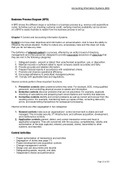Samenvatting
Accounting Information Systems - Chapter 7 Control and Accounting Information Systems - Summary
- Instelling
- Avans Hogeschool (Avans)
Explains types of control activities and the definition of internal controls. Equips you with the internal control toolkit and the relevant frameworks which are COBIT, COSO, and COSO-ERM. Lastly, it explains how you identify, assess, respond, monitor risks and fraud.
[Meer zien]





